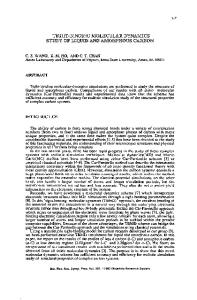Dynamics of Liquid Lithium Atoms. Pseudopotential and EAM-Type Potentials
- PDF / 715,508 Bytes
- 7 Pages / 612 x 792 pts (letter) Page_size
- 74 Downloads / 304 Views
AND LIQUIDS
Dynamics of Liquid Lithium Atoms. Pseudopotential and EAM-Type Potentials R. M. Khusnutdinoff*, B. N. Galimzyanov, and A. V. Mokshin** Kazan (Volga region) Federal University, Kazan, 420008 Russia *e-mail: [email protected] **e-mail: [email protected] Received August 22, 2017
Abstract—It is generally accepted that the complicated character of the interparticle interaction in liquid metals is reproduced most correctly by many-particle potentials of the EAM-type (embedded atom model) interparticle interaction. It is shown that in the case of liquid lithium near the melting temperature (Tm = 453.65 K), the spherical pseudopotential provides a better agreement with experimental data on elastic and inelastic X-ray scattering as compared to the known EAM potentials. The calculations of the dynamic structural factor and spectral densities of the longitudinal and transverse atomic currents lead to the conclusion that although the pseudopotential and EAM potentials generate a certain qualitative correspondence in the features of collective dynamics, the interparticle interaction of the spherical type reproduces correctly the general form of the dynamic structure factor in a certain wavenumber range, as well as the dispersion relation for collective excitations. DOI: 10.1134/S1063776118010041
1. INTRODUCTION
For reproducing the interparticle interaction in liquid lithium, various model potentials were proposed, including local [8, 9] and nonlocal [10, 11] potentials, effective [12] spherical potentials (see review [13]), as well as many-particle EAM-type potentials (embedded atom method) [14, 15] and their modifications (modified embedded atom model, MEAM) [16]. Remarkably, in accordance with a large number of methods for developing interparticle interaction potentials, the potential parameters are selected from the very outset for reproducing correctly separate regions of the phase diagram as well as structural properties. Obviously, the “correct” structure does not imply the generation of the correct dynamics and transport properties by a potential. The main goal of this study is to analyze the accuracy of the description of the structure and the microscopic dynamics of liquid lithium in the vicinity of the melting temperature using different potentials of interparticle interaction, namely, the effective spherical pseudopotential [12], the embedded atom potential (many-particle EAM potential) [15], and modified embedded atom model potential (MEAM potential) [16].
Among other alkali metals, lithium has the simplest electronic structure 1s22s1 (two inner s-electrons and one valence electron). According to the number of nucleon and electrons, lithium can be considered as the simplest metal existing in nature [1, 2]. Nevertheless, many properties of lithium melt are quite nontrivial, due to the specific ion–ion interaction [3], even as compared to other liquid alkali metals. For example, the potentials constructed on the basis of the local pseudopotential (e.g., Ashcroft potential [4]) for lithium cannot be u
Data Loading...










